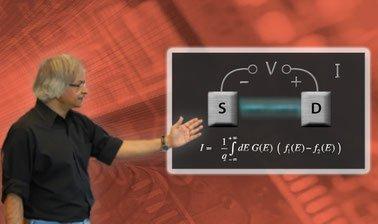MOOC List is learner-supported. When you buy through links on our site, we may earn an affiliate commission.

MOOC List is learner-supported. When you buy through links on our site, we may earn an affiliate commission.
The traditional description of electronic motion through a solid is based on diffusive transport, which means that the electron takes a random walk from the source to the drain of a transistor, for example. However, modern nanoelectronic devices often have channel lengths comparable to a mean free path so that electrons travel ballistically, or "like a bullet."
This course is part of the Nanoscience and Technology MicroMasters.
What you'll learn
- Ballistic and diffusive conductance
- Density of states
- Number of modes
- Conductivity
- Landauer formula
Syllabus
Week 1: The New Perspective
1.1 Introduction
1.2 Two Key Concepts
1.3 Why Electrons Flow
1.4 Conductance Formula
1.5 Ballistic (B) Conductance
Week 2: The New Perspective (Continued)
1.6 Diffusive (D) Conductance
1.7 Connecting B to D
1.8 Angular Averaging
1.9 Drude Formula
1.10 Summing Up
Week 3: Energy Band Model
2.1. Introduction
2.2. E(p) or E(k) Relation
2.3. Counting States
2.4. Density of States
2.5. Number of Modes
Week 4: Energy Band Model (Continued)
2.6. Electron Density (n)
2.7. Conductivity vs. n
2.8 - 2.9 Bonus Lectures; NOT covered on exams
2.10 Summing Up
Week 5: What and Where is the Voltage
3.1 Introduction
3.2 A New Boundary Condition
3.3 Quasi-Fermi Levels (QFL's)
3.4 Current from QFL's
3.5 Landauer Formulas
3.6 - 3.10 Bonus Lectures; NOT covered on exams
MOOC List is learner-supported. When you buy through links on our site, we may earn an affiliate commission.
MOOC List is learner-supported. When you buy through links on our site, we may earn an affiliate commission.
